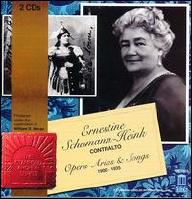She had to endure an uncommon amount of trouble in her life. She married Ernst Heink before she was twenty-one. He gave her four children then deserted the family. At one point she was driven by despair and poverty to take herself and the children to the railroad-yard with the intent of throwing themselves before a train. She got an engagement in Hamburg, and quickly became a star by substituting when Marie Goetz became ill and could not sing Carmen, Fides (in Le prophete), and Ortrud. Mahler became the conductor in Hamburg, and cast her in the alto Wagnerian roles of Fricka, Erda, and BrangŠne. She built a leading career in Germany. In 1893 she divorced her absent husband and married a lawyer, Paul Schumann, thereafter singing under the name "Schumann-Heink." She made a notable Covent Garden debut in 1896, and then went west to conquer America. She became nationally popular, touring the country from the largest cities and White House appearances to little towns out west. The tours were so lucrative that she cancelled her German contracts to continue. In 1905, after the death of her second husband, she married William Rapp, a Chicago lawyer, and became an American citizen. She sang frequently at the Metropolitan Opera, but never took a long-term contract there. She shocked the musical world by appearing in a Broadway musical ("crossover" was not yet an accepted phenomenon). She was hand-picked by Richard Strauss to create the role of Klytemnaestra in his opera Elektra and was a sensation, though she ended up hating the role: "It was frightful ... we were all a bunch of mad-women," she said of the experience.
During World War I she was a tireless supporter of American forces, singing many Liberty Bod concerts, but she had the pain of knowing that sons by her first two marriages were serving in the active forces on opposite sides of the conflict. "My sympathies were with the American cause, but my heart was with my son on the other side," she said. This son, the captain of a submarine, died when his boat was lost at sea. Shortly thereafter another son died of typhoid.
Even though made in her declining years, her numerous recordings show a strong, rich voice with uncommon intelligence and musicality in matters of intepretation and phrasing. Unfortunately, her investments were wiped out in the Wall Street crash of 1929. She joined a touring vaudeville company. She was invited to Hollywood, where a producer had imagined she might become the successor to the departed actress Marie Dressler. She appeared in a musical film, Here's to Romance, but this fell flat. She died in Hollywood in 1936. ~ Joseph Stevenson, Rovi













